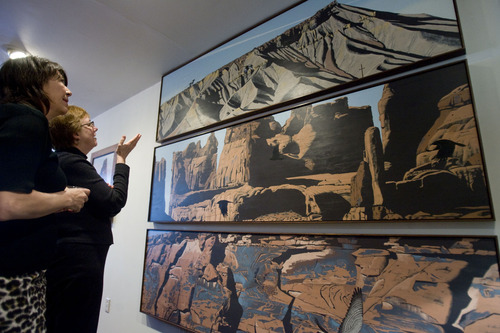This is an archived article that was published on sltrib.com in 2013, and information in the article may be outdated. It is provided only for personal research purposes and may not be reprinted.
A new exhibit at the Natural History Museum of Utah uses art to celebrate the state's geology recorded in ancient dunes and seabeds and the memory of East High School English teacher Cheryl Grubb Funston.
On commission from the Funston family, Salt Lake City painter Mark Knudsen created the landscape triptych depicting three famous Utah formations: Wingate sandstone, Entrada sandstone and Mancos shale. Museum officials on Tuesday hung the three paintings on a wall that visitors pass on their way between the Earth and Sky galleries.
When the project was first proposed, museum Director Sarah George insisted it visually link these two exhibition halls. This required Knudsen, a former Salt Lake Tribune graphic artist, to rethink his original idea of painting just cliff faces.
"I resisted because I thought it would be harder to unify them. It made the second painting [of Entrada sandstone at Arches] a real challenge," Knudsen said. "I'm pleased with the way it turned out. Sarah's stipulation on the sky made it a stronger triptych."
The result is a series of cliff faces with ever increasing portions of sky shown, along with birds in flight.
"We don't purchase art for art's sake, but we want to incorporate art into the interpretation of the natural world. This helps us talk about Utah's geologic strata," said George, who consulted with University of Utah geology professor Marjorie Chan.
The museum stacked the 2-by-7-foot paintings with the oldest formation on bottom.
Starting from the lowest panel, a peregrine falcon swoops in the Wingate painting, showing a cliff on the Kane Creek Road near Moab. Ravens cross Entrada formation that Knudsen painted at Arches National Park's Park Avenue. And magpies fly across the topmost painting of Mancos shale Knudsen painted near Crescent Junction at a place he called Uranium Ridge.
Funston's husband said the work reflects the teaching values of the late teacher, who died two years ago from ovarian cancer.
"Cheryl knew kids needed to interact to learn. It wasn't enough to just read the play," Guilford Funston said. "It's the idea of not just seeing a rock or a bone, but [having] something to interpret the rock and bone. That goes along with the other exhibits the museum put together."









